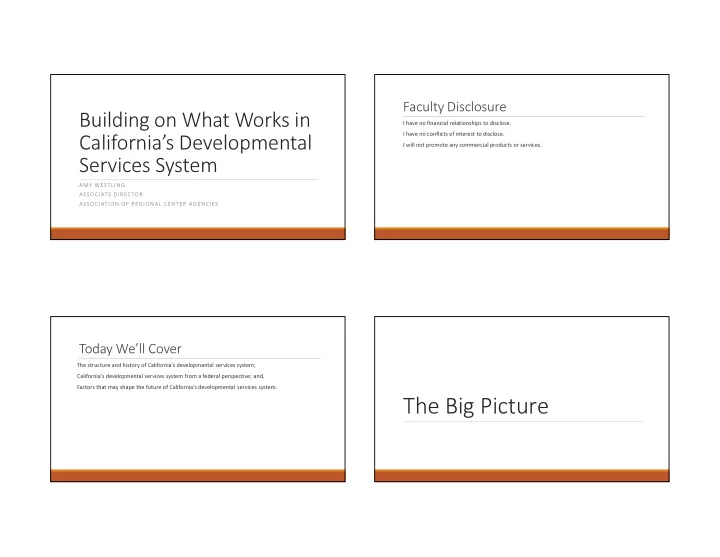

Faculty Disclosure Building on What Works in I have no financial relationships to disclose. I have no conflicts of interest to disclose. California’s Developmental I will not promote any commercial products or services. Services System AMY WESTLING ASSOCIATE DIRECTOR ASSOCIATION OF REGIONAL CENTER AGENCIES Today We’ll Cover The structure and history of California’s developmental services system; California’s developmental services system from a federal perspective; and, Factors that may shape the future of California’s developmental services system. The Big Picture
What Makes California’s System Unique? Regional Center Goals Started with family advocacy; Help infants and toddlers to make developmental progress; Pre-dated federal funding for community services; Keep minor children at home; and, Entitlement to services; and, Support adults to live as independently as possible. Local control. Funding California’s Developmental Regional Center Functions Services System Intake and eligibility; Total community-based budget: $6.1 billion Sources of Funds 100% Service planning; Total federal contribution: $2.5 billion 90% Clinical support; Federal share: 40% 80% 70% Fill service gaps; and, 60% Meet federal expectations. 50% 40% 30% 20% 10% 0% Dollars (in billions) Other 0.02 General Fund 3.63 Federal Funds 0.05 Federal Reimbursements 2.40
How Federal Funding Flows Most funding comes through the Department of Health Care Services for Medi-Cal recipients. Special education funding supports the Early Start program. The Federal Perspective Trends at the Federal Level Measuring Outcomes Person-centered planning; The aim of the service system is to provide quality services that help individuals to Conflict-free case management; achieve their goals. Higher levels of community integration; and, The National Core Indicators project allows California to compare its performance to other Greater community employment. states.
Statewide Systemic Considerations Who is being served? What services and supports will enable families to stay together? Where are there opportunities for systems enhancement? Looking Ahead How can funding be adjusted to ensure sustainability?
Concerns on the Horizon A Final Thought Proposed changes to the following could have “We were clearing away new paths to get the a major impact: work done, to get what we needed. They didn’t exist, so we had to work on it so that they did ◦ The Affordable Care Act; exist.” ◦ Medicaid funding structures; ◦ Medicare; and, ◦ Special education. - Asenath Young Resources www.dds.ca.gov www.arcanet.org http://www.nationalcoreindicators.org/ https://hcbsadvocacy.org/ http://lanterman.org/uploads/miscellaneous/WereHeretoSpeakforJustice_LAntermanCommBro -ver2.pdf
Recommend
More recommend